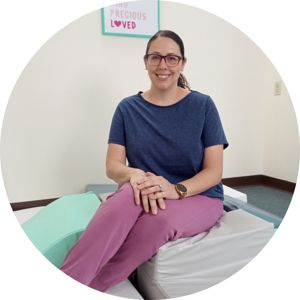It takes specialized training to work with babies who have oral motor dysfunction or feeding trouble. Over the past several years, I have received more training and continued my education in the treatment of tethered oral tissues and oral motor dysfunction. I have gathered my favorite “tools” to use and recommend to families. In this blog post I will be discussing pacifiers and teethers and their use in oral motor development.
What to Look for in a Pacifier
A baby has a reflexive suck until about 3-4 months of age. A pacifier is introduced to help a baby soothe and to help them work on their suck through suck training. I look for the optimal characteristics of a pacifier.
As a pediatric physical therapist who works with infants, I use suck training to help with tongue mobility and strength. A pacifier that has a cylindrical shape to it will allow the tongue to elevate and cup around it to keep it in. A pacifier that has a flat side will push down the tongue and cause the infant to use a compression motion instead of a suck. I often hear parents say that their baby does not want to keep a pacifier in. However, it is most likely that the baby has trouble coordinating their tongue to actively keep it in their mouth.
A full body assessment by an experienced therapist is recommended to rule out oral motor dysfunction or oral ties. These are the pacifiers I recommend:
- Ninni
- Soft silicone, shaped like a breast, which helps to reinforce the proper latch
- Discount link or use code Ahoybaby: https://ninnico.com?p=B1hru-Unc
- Avent Soothie
- The cylindrical shape allows for tongue cupping and elevation to achieve a proper sucking pattern
- Dr. Brown Happy Paci
- Soft silicone with a tapered cylindrical shape to help with proper latch
Once your baby has their suck reflex integrated, you will see them show more interest in munching/chewing on things.

What to Look for in a Teether
Around 3- 4 months of age, you will notice that babies are putting everything in their mouths. A baby will use a teether, not only to soothe their gum but to help strengthen the muscles in their tongue, jaw, and lips. When a baby moves the teether around in their mouth, they work on tongue coordination. A baby engaging in teether play is working on all of the skills necessary for feeding, speech production, and swallowing.
Teethers often come with different textures, which give babies the chance to process a variety of sensations and help with sensory development. A baby works on their hand-eye coordination by bringing teethers to their mouth. This hand-eye coordination will help with self- feeding. A huge skill that is developed by using teethers is the ability to self-soothe.
Teethers come in a variety of different shapes and sizes. Using teethers will also help a baby normalize their gag reflex which is important for eating. Here are a few of my favorites. All of these are lightweight and easy to hold without sharp edges.
- Chewing Tube Teether
- Soft, easy to hold, and clean.
- Baby works on hand-eye coordination bringing to mouth and to each side where they will work on tongue lateralization (tongue moving to side to follow teether).
- They will also work on munching on it when it is on the side of their mouth.
- The lateralization and munching will help prepare the mouth for eating solids.
- O Ball
- Babies love this toy.
- It is easy to hold and bring to the mouth.
- This is a great toy to work on tongue extension. You will see the baby sticking their tongue through all of the holes.
- Innobaby Star Teether
- Easy to hold.
- Soft with different textures and shapes on each side.
- Allows for good tongue mobility to get to different textures.
- Discount link for 15% off or use code ahoybabypt: https://innobaby.com/?ref=ahoybabypt
- Innobaby Fruit Teether
- Lightweight and easy to hold.
- Different textures on each side.
- I like to hold the teether sideways to get the baby to open their mouth up nice and wide.
- Discount link for 15% off or use code ahoybabypt: https://innobaby.com/?ref=ahoybabypt
Tips for Making Teether Play Beneficial
- Teether play can start as early as 3 months. A baby may not have the grasp or hand-eye coordination to bring to their mouth independently at this age, but a parent can offer the teether toy.
- Offer a variety of shapes, sizes, and textures.
- Clean the teethers frequently. I clean my teethers in a bottle sterilization bag for the microwave.
Teether play is essential to a baby’s development to help with future skills such as eating and speaking. Please reach out to an experienced therapist if you are looking for more guidance on your child’s oral motor development or development in general.






